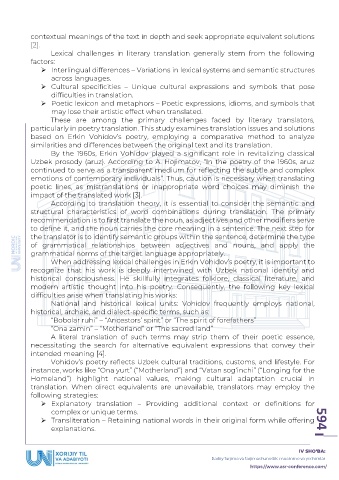Page 596 - Konferensiya to'plami - 1 (ASR)
P. 596
contextual meanings of the text in depth and seek appropriate equivalent solutions
[2].
Lexical challenges in literary translation generally stem from the following
factors:
➢ Interlingual differences – Variations in lexical systems and semantic structures
across languages.
➢ Cultural specificities – Unique cultural expressions and symbols that pose
difficulties in translation.
➢ Poetic lexicon and metaphors – Poetic expressions, idioms, and symbols that
may lose their artistic effect when translated.
These are among the primary challenges faced by literary translators,
particularly in poetry translation. This study examines translation issues and solutions
based on Erkin Vohidov’s poetry, employing a comparative method to analyze
similarities and differences between the original text and its translation.
By the 1960s, Erkin Vohidov played a significant role in revitalizing classical
Uzbek prosody (aruz). According to A. Hojimatov, “In the poetry of the 1960s, aruz
continued to serve as a transparent medium for reflecting the subtle and complex
emotions of contemporary individuals”. Thus, caution is necessary when translating
poetic lines, as mistranslations or inappropriate word choices may diminish the
impact of the translated work [3].
According to translation theory, it is essential to consider the semantic and
structural characteristics of word combinations during translation. The primary
recommendation is to first translate the noun, as adjectives and other modifiers serve
to define it, and the noun carries the core meaning in a sentence. The next step for
the translator is to identify semantic groups within the sentence, determine the type
of grammatical relationships between adjectives and nouns, and apply the
grammatical norms of the target language appropriately.
When addressing lexical challenges in Erkin Vohidov’s poetry, it is important to
recognize that his work is deeply intertwined with Uzbek national identity and
historical consciousness. He skillfully integrates folklore, classical literature, and
modern artistic thought into his poetry. Consequently, the following key lexical
difficulties arise when translating his works:
National and historical lexical units: Vohidov frequently employs national,
historical, archaic, and dialect-specific terms, such as:
“Bobolar ruhi” – “Ancestors’ spirit” or “The spirit of forefathers”
“Ona zamin” – “Motherland” or “The sacred land”
A literal translation of such terms may strip them of their poetic essence,
necessitating the search for alternative equivalent expressions that convey their
intended meaning [4].
Vohidov’s poetry reflects Uzbek cultural traditions, customs, and lifestyle. For
instance, works like “Ona yurt” (“Motherland”) and “Vatan sog‘inchi” (“Longing for the
Homeland”) highlight national values, making cultural adaptation crucial in
translation. When direct equivalents are unavailable, translators may employ the
following strategies:
➢ Explanatory translation – Providing additional context or definitions for
complex or unique terms.
➢ Transliteration – Retaining national words in their original form while offering 594
explanations.
IV SHO‘BA:
Badiiy tarjima va tarjimashunoslik: muammo va yechimlar
https://www.asr-conference.com/

